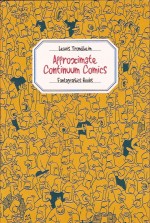
By Lewis Trondheim, edited & translated by Kim Thompson (Fantagraphics Books)
ISBN: 978-1-60699-410-8
With over 100 books sporting his name, (which isn’t actually Lewis Trondheim but Laurent Chabosy) the writer/artist/editor and educator is one of Europe’s most prolific comics creators: illustrating his own work and working with the industry’s top artists; overseeing animated cartoons of his print successes as La Mouche (The Fly) and Kaput and Zösky and even editing a younger readers book series Shampooing for Dargaud.
His most famous works are the global hits ‘Les Formidables Aventures de Lapinot’ (translated as The Spiffy Adventures of McConey) and, with Joann Sfar, the Donjon (Dungeon) series of nested fantasy epics (see the translated Dungeon: Parade, Dungeon: Monstres and Dungeon: the Early Years).
In his spare time he has written for satirical magazine Psikopat and his scripts for the continent’s most popular artists include Le Roi Catastrophe and Vénézia with Fabrice Parme, Les Cosmonautes du futur (Manu Larcenet), Allez Raconte and Papa Raconte (José Parrondo) and Petit Père Noël (Thierry Robin).
He is a cartoonist of uncanny wit, piercing, gentle perspicacity, comforting affability and self-deprecating empathy who prefers to control scrupulously what is known and said about him…
I first became aware of Lewis Trondheim’s subtly engaging comics mannerism in Fantagraphics’ Mome anthologies which reprinted excerpts of his comics blog Little Nothings wherein Trondheim’s friends and acquaintances, drawn as anthropomorphised animals (with him a dowdy, parrot-beaked central figure) revisit episodes of his life, flavoured with philosophy, personal introspection, whimsical inquiry and foible-filled observations.
These mini-treats have since been gathered into three terrific tomes of drawn diaries for constant re-reading (Little Nothings: Curse of the Umbrella, The Prisoner Syndrome and Uneasy Happiness) and are available as collected gift set entitled Bigger Nothings.
However, before all that Trondheim first explored the idea as a four issue American styled comicbook project in 1993 and those prototypical slices of wry and winning reportage are finally available in a translated black and white softcover collection.
Some of the very first autobiographical works on the French bande dessinée scene, these little gems were a genuine game-changer for cartoonists and storytellers, prompting a rise in personal stories that has produced many works to rival the best of Harvey Pekar himself…
In the collected Approximate Continuum Comics the trademark blend of visualised introspection and self-condemnatory flagellation finds the younger Trondheim questioning his own professional integrity, violently and graphically wish-fulfilling his way through rush-hour crowds (haven’t we all?), planning – for which read risk-assessing – his marriage, and dealing with his unfathomable Japanese publisher during the early days of creating his multi-media hit La Mouche.
He regularly gets lost in his own free-associating daydreams and rightly fears being castigated by his own conscience for swimming in megalomania, indecisiveness, forthrightness and deference.
Trondheim’s many inner voices don’t like him very much: there are myriad incidences of self-abuse where his alternate egos beat the crap out of him; counterbalanced with gloriously loaded “real-world†episodes where he lampoons and embarrasses his fellow studio-mates of publishing collective L’Association.
(To be fair these are fabulously balanced by a marvellous section at the book’s end where such maligned and injured creative colleagues as David B., Emile Bravo, Didier Tronchet, Jean-Christophe Menu, Killofer and Philippe Dupuy among others, as well as civilian friends, his wife Brigitte and even his mother all get a trenchant and often hilarious right-to-reply.)
The first inklings of the artist’s perennial problems with technology in general and computer games in particular appear here, as do many childhood memoirs and sundry diatribes against people and places either experienced or sometimes only imagined.
One of the best sequences concerns the trip-of-a-lifetime to America (first of many, but he didn’t know that then…) and his apparent inability to think of one single strip idea about it, only surpassed by his behaviour at a raucous party held in his beloved studio.
During the course of these cartoon capers, Trondheim married his fiancée, sired his first child and moved into a new home, but although these major events are thoroughly and compellingly covered they still pale into insignificance against the spectacular battles against his inevitably spreading paunch, obsessively mean-spirited self-criticism and the thunderbolt-like occasional phone call from his mum…
…And whenever that’s no longer painful enough there’s always the violent physical assaults and punishment-beatings from his inner selves…
Superbly skilled at switching imperceptibly from broad self-parody to cripplingly painful personal revelation, wild surrealism to powerful reportage and from clever humorous observation to howling existentialist inquisition, Trondheim’s cartoon interior catalogue is always a supremely rewarding and enjoyable experience and, as these ancient texts prove, always has been…
© 2001 Lewis Trondheim and Cornélius. This edition © 2011 Fantagraphics Books. All Rights Reserved.
